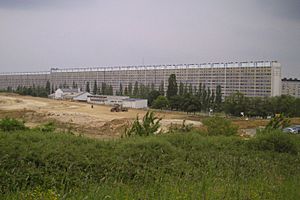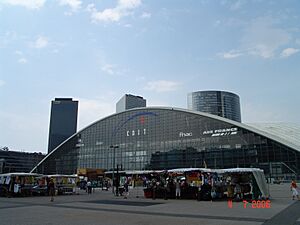Bernard Zehrfuss facts for kids
Bernard Louis Zehrfuss (born in Angers, France, on October 20, 1911 – died in Neuilly-sur-Seine, France, on July 3, 1996) was a famous French architect. He designed many important buildings, including parts of the UNESCO headquarters and the Center of New Industries and Technologies in Paris.
Life of Bernard Zehrfuss
Bernard Zehrfuss was born in Angers, a city in France. His family had moved there from Alsace in 1870, after a war between France and Prussia.
Sadly, Zehrfuss's father died in a battle during World War I in 1914. When Bernard was 18, he started studying at the École des Beaux-Arts in Paris, which is a very famous art school. In 1939, he won the Prix de Rome, a top award for artists and architects. This award would have let him study in Rome, but World War II started, so he couldn't go.
After a short time in Nice, he worked as an assistant in a workshop in Marseilles. He then helped start a small art group called Groupe d’Oppède. Later, he joined the Free French Forces, a group that fought against the occupation of France during the war.
From 1943 to 1953, Zehrfuss worked in Algeria and Tunisia, which were controlled by France at the time. He was in charge of public works and designed many successful buildings. These included homes, schools, and hospitals.
When he returned to France, he became the Chief Architect for Public Buildings. He worked on two very important projects:
- The European headquarters for UNESCO in 1953. He worked with other famous architects, Marcel Breuer and Pier Luigi Nervi.
- The Center of New Industries and Technologies (CNIT) in 1958. This was one of the first big buildings in the La Défense area near Paris.
Throughout the 1960s and 1970s, he also designed many housing projects and embassies for France. In 1975, he designed a new building for the Gallo-Roman Museum of Lyon. In 1983, Zehrfuss became a member of the Academy of Fine Arts. He later became the permanent secretary of the Academy in 1994.
Bernard Zehrfuss passed away in Neuilly-sur-Seine in 1996.
Main Buildings Designed by Zehrfuss

Here are some of the most important buildings Bernard Zehrfuss designed:
- 1939: Stade Charléty in Paris. This stadium was later rebuilt.
- 1950–1953: The Mame printworks in Tours, working with Jean Prouvé.
- 1950–1958: The Flins Renault Factory and the nearby housing area in Flins-sur-Seine.
- 1952–1958: The UNESCO headquarters in Paris. He also worked on its expansion later.
- 1954–1958: The CNIT at la Défense, with Robert Camelot and Jean de Mailly.
- 1959–1963: The Haut-du-Lièvre housing complex near Nancy.
- 1960–1963: The Faculty of Sciences for the University of Tunis.
- 1962–1967: Apartment towers in Pantin, which included 370 homes.
- 1962–1970: The French embassy in Warsaw, Poland.
- 1967: Garonor, a large logistics center in Aulnay-sous-Bois.
- 1968: The headquarters for Sandoz-France in Rueil-Malmaison.
- 1970: The Danish Embassy in Paris.
- 1972: The Siemens-France headquarters in Plaine-Saint-Denis.
- 1972–1975: The Gallo-Roman Museum of Lyon.
- 1973: Tour Anjou, a building at la Défense.
- 1976: The headquarters for Jeumont-Schneider in Puteaux.
- 1976: Apartment buildings in the 15th arrondissement of Paris.
See also



